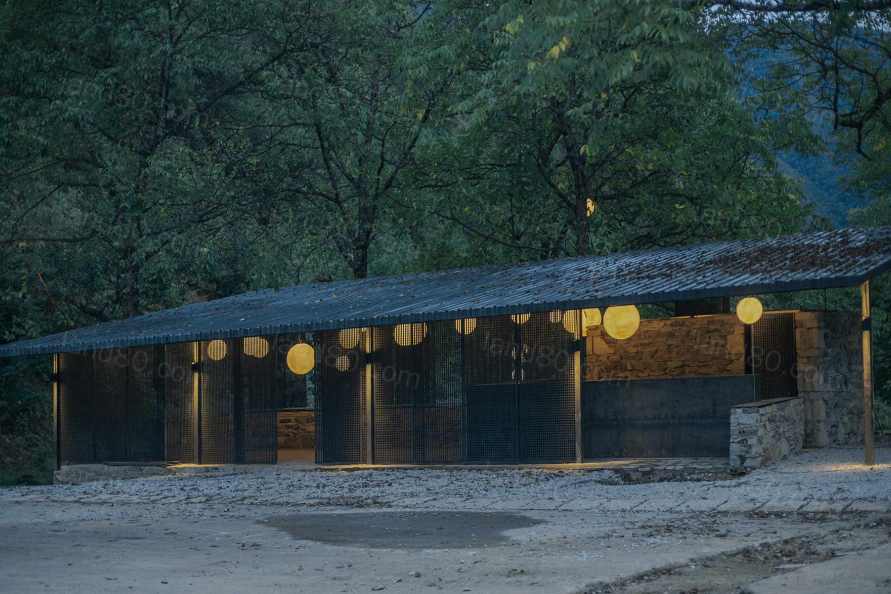
△ 林里亭夜景Woodland Pavilion from afar
背景与环境 Background & Environment
位于云南省迪庆州的滇金丝猴国家公园是一处占地300多平方公里的天然秘境,高海拔、零污染以及丰富的植物资源使这里成为了滇金丝猴最后的家园,吸引着全世界的游客;此次建筑师接受委托对国家公园入口有限的设施进行改造和提升,以满足更多元化的需求。
Located in Diqing Prefecture of Yunnan province, Snub-nosed Monkey National Park is a naturally scenic site covering more than 300 square kilometers. Attracting visitors from around the world, its high altitude, pollution-free air, and abundant vegetation lent it the status as the last home of the black snub-nosed monkeys. The architect was commissioned to renovate and upgrade the outdated facilities near the park's entrance to fulfill more diverse needs.

△ 露天电影广场Open air movie terrace

△ 篝火广场全景Fire pit amphitheater
场地与条件 Site & Conditions
国家公园入口处为一片自然坡地,被道路和停车场划分为大小不一的几片核桃树林,一条雪山融化的小溪自北向南穿过场地,水声潺潺,引人忘忧。
The entrance site is a natural slope comprised of walnut groves cut into varying sizes by roads and parking lots; a babbling brook flowing with snowmelt mountain water cuts through the site from north to south; its trickling noise soothes any weary mind upon encounter.

△ 临溪亭全貌New pavilion roof parallel to terrace's line of descent

△ 远望临溪亭Streamside Pavilion from afar

△ 临溪吧台Streamside countertops

△ 林里亭一角Roadside facade with lower eaves
需求与策略 Program & Strategy
委托方希望在国家公园入口处的场地建设帐篷营地,并设置满足休闲住宿的服务设施,供人亲近自然,留宿林间;建筑师的设计策略是最小限度的干预自然,将可收起的住宿帐篷依势错落,临溪布局,以求各自观溪,枕水而眠;与此同时,建筑师以极为克制的设计手法,仅新筑两处方亭,以满足必要的接待和餐饮需求。
The client’s intention was to set up campsites and new service facilities near the park’s entrance, allowing visitors to remain close to nature whilst residing in the forest. The architect's strategy was simple: to minimize interference with nature by using retractable tents – alternatingly placed along the stream, so each tenant can enjoy a view to the water as they drift into sleep. Moreover, the architect restrained the extent of intervention by only building two new pavilions elsewhere – thereby meeting the most essential needs for reception and dining.


△ 林中望亭View from forest

△ 吧台对望Interior scenery
1 林里亭 Woodland Pavilion
功能与形式:Function and Form
林里亭的使用功能为营地接待中心,落位紧邻道路,建筑师采用单侧低垂的平行四边形单坡屋顶塑造形式,将接待前台、值班收纳、客人休息等功能空间覆于其下,各个功能布局相互穿插,行为流线围绕转折长桌,自由通畅,以便多种经营布置灵活切换。
Adjacent to the road, Woodland Pavilion serves as the campsite’s reception area. United under a single shed roof, the architect compacted the front desk, lounge, storage, and other functions into an interconnected whole. A long, custom-crafted table flows and twists through its space, allowing activities to unfold around it – all the while keeping a variety of other layout options available for change.

△ 道路一侧望亭View from road further down

△ 遁入自然的亭Hidden platform pavilion
结构与材料 Structure and Material
林里亭采用钢结构建造,梁柱结构施以重色,力求纤细清晰;地台长桌及房间墙体则用现场石块就地砌筑,不择形色,粗犷质朴。
Woodland Pavilion was constructed out of light-steel structure painted in dark colors, appearing slender and clean. The long table and walls are built out of locally sourced stones from the park, exuding a rustic charm.

△ 转折的钢台成为一件家具Turning detail of steel counter

△ 水平钢台临近景观布置Horizontal steel counter floating above the terraced steps

△ 水平钢台临水抱树Steel counter weaved around tree

△ 水平钢台成为座椅Steel counter as bench

△ 水平钢台与倾斜的屋顶和地面Angled roof parallel to terraced platform and horizontal steel counter

△ 钢台与结构柱相连Connection detail of steel counter and column

△ 纤细简明的结构体系Slender light-steel structures
界面与装饰 Furnishings and Décor
林里亭倾斜的单坡屋面在道路一侧尽量压低,削弱车流人流对亭中环境的影响,另一侧屋顶则挑高延展,以便尽观林景;两侧皆设置细密的通高格栅,格栅可开可合,配合无序灯球,随意取舍。
Towards the road, the pavilion’s roof is sloped down to obstruct noise into the building; on the other side, the roof is raised and extended, framing a full view of the forest beyond. Both sides are lined with floor-to-ceiling operable louvers. When opened or closed, coupled with spherical lights scattered within, the pavilion appears playful yet boundless.

△ 朝向景观一侧屋面抬起Woodland Pavilion's roof raised towards the forest

△ 临水的钢台引人亲近自然Steel counter near stream


△ 亭里望林Forest as viewed from interior
2 溪边亭 Streamside Pavilion
功能与形式 Function and Form
溪边亭的功能是餐饮服务,原址为一处修建数载、层层跌落的石材台基,台基紧邻雪山溪水,两棵婀娜古树在石材边界肆意生根,天然生动;初到此处石台,溪边树下,水声延绵,便认定此处应设一亭,所谓台等亭来。所设新亭也极简练,十根方柱撑起单坡屋面,屋面坡度与跌落的石台相互平行,仿佛建台筑亭一体而为。
The function of Streamside Pavilion is to serve as a dining spot. Its original site had an outdated stone terrace which have been repeatedly repaired. Bounded by the stream with snowmelt water, as well as two graceful, timeless trees rooted near its edge, the platform naturally lent itself a place in the architect’s mind upon first visit as an idyllic resting spot – hence his expression “a platform awaits a pavilion”. This new pavilion is also very simple: a single shed roof propped up by ten square columns, sloping in parallel to stone terrace’s direction of descent, as if ground and roof were a singular entity.

△ 亭内布置Interior furnishings

△ 亭内多功能桌台Twisting stone counter

△ 亭中石台Stone counter within Woodland Pavilion

△ 透过格栅的林景Forest as viewed from interior
结构与材料 Structure and Material
溪边亭同样采用纤细的钢结构建造,屋顶轮廓呼应原有石台,新建的操作服务空间墙体也由周边天然石材砌筑,与石台融为一体。
Streamside Pavilion employed the same slender structural language from before; except this time, the roof’s edge is defined by the stone terrace’s outline. In addition, walls of newly added service space are made with natural stone, becoming one with the platform.

△ 融于自然的亭台View of Streamside Pavilion from opposite side

△ 溪中望亭Pavilion as viewed from stream below

△ 水平钢台成为临溪吧台Steel countertop and bar stools

△ 体型明确的单坡屋面Stone walls with staggered heights

△ 临近道路一侧檐口低垂Roadside edge defined by louvers
界面与装饰 Furnishings and Décor
不同于林里亭相对繁琐的装饰界面,溪边亭力求简洁清晰,最大限度的表现场所特征;唯一的新增操作是在同样倾斜的屋顶和石台之间设一道连续的水平钢台,钢台随着石台的跌落与地面形成不同高差,由左至右依次成为了吧台、桌台和座椅,并在平面上自由转折,亲水抱木,引人入境。
Unlike Woodland Pavilion and its busy décor, Streamside Pavilion strived for simplicity and clarity, allowing maximum transparency to its surrounding features. The only new intervention is a continuous, horizontal plane of steel weaved between the sloping roof and terrace. From left to right, depending on its height to the terrace steps, it is simultaneously a bar counter, table, and bench. Twisting and turning through space, its proximity to nature and whimsical form attracts visitors to enter and explore.

△ 朴素的材料搭配Masonry and steel as main materials

△ 公共区域Campsite public area




△ 帐篷内景Tent view from interior

△ 帐篷阳台Tent balcony
结语 Final Remarks
此次所筑两亭,建筑师基本都在现场:驻场设计、驻场监造,偶有调整犹豫,也能就地判断优劣,即刻解决;不同于传统设计过程的由绘制图纸到施工实施的分离与秩序,此次造亭更加即兴,甚至散漫,却也不乏自然天真,简单松弛,是一次颇为愉悦的设计建造经验。
For the two pavilion’s construction, the architect was essentially fully immersed on-site: designing on-the-spot, site supervision, occasional adjustments – it all lent the process the added upside of immediacy and instant problem-solving. Different from conventional design process, where stages between drawing to construction were clearly outlined, this intervention was more impromptu, even casual – but neither was it naïve or loose. It was an overall joyful design-build experience.


△ 平面Plan
项目名称:秘境筑亭-香格里拉滇金丝猴国家公园环境提升
项目类型:建筑/景观
设计方: 金磊 北京土驻设计事务所创始合伙人 主持建筑师
联系邮箱:jinleiarchitecture@126.com
项目设计:2022.8
完成年份:2022.10
设计团队:金磊 Angrybircai 王霹雳 孟寒 周彦邦
项目地址:云南省迪庆州香格里拉维西县塔城镇
建筑面积:200.0㎡
摄影版权:金磊
客户:滇金丝猴国家公园 北京柒影文化传媒有限公司
|